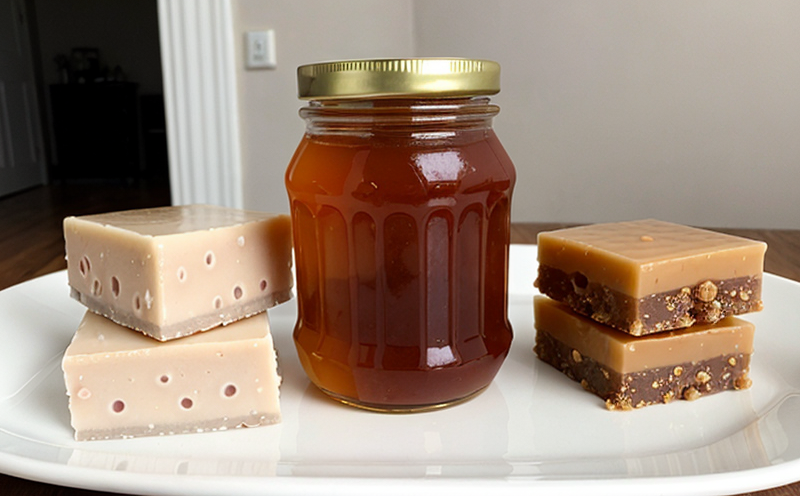AOAC 982.30 Tocopherol (Vitamin E) Analysis in Confectionery
The analysis of tocopherols or Vitamin E content is critical to the food and feed testing sector, particularly for confectionery products where compliance with international standards such as AOAC International's method 982.30 is paramount.
AOAC 982.30 provides a standardized protocol for the quantification of tocopherols in various food matrices including confectionery. This method uses liquid chromatography coupled with ultraviolet (LC-UV) detection to separate and quantify the different forms of Vitamin E present in the sample. The importance of this test lies in ensuring that the product meets regulatory requirements regarding nutrient content, which can impact consumer health and safety.
During analysis, a representative portion of the confectionery is extracted using an appropriate solvent. This extraction process typically involves sonication to ensure thorough dissolution of tocopherols from the sample matrix. After extraction, the solution is filtered through a fine filter and injected into the LC-UV system for separation and quantification.
The method's accuracy and precision are validated by comparison with certified reference materials or spiked samples. This ensures that the results obtained can be trusted for quality control and product labeling purposes. Compliance with AOAC 982.30 is essential in maintaining a consistent vitamin profile, which is crucial for products like chocolate bars, gum, and other confectionery items.
The significance of this method extends beyond just compliance; it also ensures that the product meets consumer expectations regarding health benefits associated with Vitamin E consumption. This includes reducing the risk of chronic diseases such as heart disease and certain types of cancer. Additionally, adherence to such methods helps in maintaining a competitive edge by ensuring superior product quality.
Given the complexity of confectionery products, which often contain numerous ingredients that can interfere with analysis, AOAC 982.30 provides robust protocols for overcoming these challenges. The method's ability to accurately measure tocopherols despite such interferences is a testament to its reliability and applicability in real-world scenarios.
For quality managers, compliance officers, R&D engineers, and procurement teams within the food and feed testing sector, AOAC 982.30 offers a standardized approach that ensures consistent results across different laboratories. This standardization not only enhances data comparability but also supports regulatory compliance efforts, which are crucial for maintaining consumer trust.
Understanding the nuances of this method is essential for those involved in food and feed testing, especially when dealing with confectionery products. By leveraging AOAC 982.30, laboratories can provide accurate, reliable, and consistent results that meet both internal quality standards and external regulatory requirements.
Benefits
The implementation of AOAC 982.30 for the analysis of tocopherols in confectionery brings numerous benefits to food and feed testing laboratories:
- Enhanced Compliance: Ensures strict adherence to international standards, thereby avoiding legal penalties and maintaining a good reputation.
- Informed Decision-Making: Provides accurate data for R&D teams to innovate and improve product quality.
- Consumer Trust: Ensures that the products meet regulatory requirements regarding nutrient content, which enhances consumer trust in the brand.
- Competitive Edge: By maintaining consistent vitamin profiles, food manufacturers can differentiate their products in a crowded market.
- Data Consistency: Standardized protocols ensure that results are consistent across different batches and laboratories, leading to more reliable outcomes.
- Regulatory Compliance: Helps companies comply with international regulations, which is crucial for exporting goods.
The benefits extend beyond mere compliance; they contribute significantly to the overall quality management framework of food and feed testing labs. By adopting AOAC 982.30, laboratories can ensure that their processes are efficient, effective, and compliant with international standards.
Customer Impact and Satisfaction
The adoption of AOAC 982.30 by confectionery manufacturers has a direct impact on customer satisfaction. By ensuring accurate vitamin E content in products, manufacturers can meet regulatory requirements and provide consumers with reliable information about the nutritional value of their purchases.
For quality managers, compliance officers, R&D engineers, and procurement teams, the use of this method translates into enhanced product quality and reliability. This not only improves customer satisfaction but also fosters a positive brand image. Consumers are more likely to trust brands that demonstrate commitment to high standards in production processes.
The analysis provided by AOAC 982.30 helps in maintaining consistent vitamin profiles across different batches of confectionery products. This consistency ensures that each product meets the expected nutritional content, thereby enhancing consumer confidence and satisfaction.
Furthermore, compliance with this method can lead to regulatory approval and certification, which are critical for market access. This not only opens up new markets but also strengthens brand credibility. By ensuring that their products meet international standards, manufacturers can compete effectively in both domestic and international markets.
Environmental and Sustainability Contributions
The use of AOAC 982.30 for the analysis of tocopherols in confectionery contributes positively to environmental sustainability efforts. By ensuring accurate vitamin E content, manufacturers can minimize waste by producing only what is needed, thus reducing resource consumption.
Accurate measurement of tocopherols also helps in optimizing production processes, leading to reduced energy consumption and emissions. This aligns with broader sustainability goals such as reducing carbon footprints and promoting sustainable practices within the food industry.
The method's precision ensures that no unnecessary additives are used, which can further reduce environmental impact. By adhering to international standards like AOAC 982.30, manufacturers can contribute to a more sustainable future by making informed decisions about their production processes.
Moreover, the use of this method helps in maintaining consistent vitamin profiles across different batches and laboratories. This consistency ensures that each product meets the expected nutritional content, thereby enhancing consumer satisfaction and reducing returns or recalls due to mislabeling or incorrect nutrient claims.





